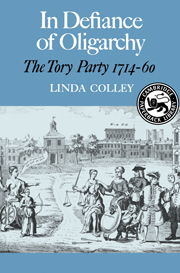Book contents
- Frontmatter
- Contents
- For my parents and Toby
- Preface
- Part I The Problem of Tory Survival
- Part II The Ingredients of Tory Survival
- 3 The Tory Party in Parliament
- 4 The Content of Toryism
- 5 The Tory Party in the Constituencies
- 6 The Fabric of the Tory Appeal
- Part III Single-Party Government Assailed
- Conclusion
- Appendix
- Manuscript Sources
- Notes
- Index
5 - The Tory Party in the Constituencies
Published online by Cambridge University Press: 03 February 2010
- Frontmatter
- Contents
- For my parents and Toby
- Preface
- Part I The Problem of Tory Survival
- Part II The Ingredients of Tory Survival
- 3 The Tory Party in Parliament
- 4 The Content of Toryism
- 5 The Tory Party in the Constituencies
- 6 The Fabric of the Tory Appeal
- Part III Single-Party Government Assailed
- Conclusion
- Appendix
- Manuscript Sources
- Notes
- Index
Summary
In Anne's reign the tones lost only one general election and that by a narrow margin; in 1715 220 tory M.P.s were returned to Parliament and in the 1761 election barely half that number. Accounting for this declension and for the party's limited survival is complicated by the dichotomous intent and chronology of most historians of the eighteenthcentury electoral system. Sir Lewis Namier concentrated his own and his research students' attention on the post-1754 period and on the pliant, colourless, and lucre-drenched electoral mores of the lesser boroughs. His famous survey in The Structure of Politics at the Accession of George HI devotes ten pages to the counties, twenty to the great borough constituencies, and 102 to Harwich, Orford, and the Cornish boroughs - an allocation which reflects the unreformed system's allocation of seats, but not the electoral conditions experienced by the mass of English voters and the bulk of tory parliamentary candidates. More recent work on the Augustan electorate has been both lively and tendentious. Geoffrey Holmes, J. H. Plumb, and W. A. Speck have dwelt on examples of non-deferential voting, on the multiplicity of contested elections under the 1694 Triennial Act, and on the antics of a growing and politicised electorate. Such evidence can obscure the fact that electoral sclerosis was already advancing. By 1690 about 38 per cent of borough seats were under private or government patronage. More than one quarter of England's 203 boroughs were not contested or were contested only once at general elections between 1700 and 1713.
- Type
- Chapter
- Information
- In Defiance of OligarchyThe Tory Party 1714-60, pp. 118 - 145Publisher: Cambridge University PressPrint publication year: 1982



